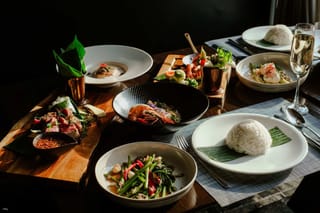Beyond Pad Thai Exploring Thailand’s Culinary Scene
A World Beyond Noodles: Exploring Regional Diversity
Thailand’s culinary reputation often rests solely on the shoulders of Pad Thai, a delicious dish, but one that only scratches the surface of the country’s vast gastronomic landscape. Venturing beyond the ubiquitous stir-fried noodles reveals a tapestry of regional cuisines, each boasting unique ingredients, cooking techniques, and flavour profiles. From the fiery curries of the south to the lighter, fresher dishes of the north, a culinary journey across Thailand is an adventure for the senses.
Northern Thailand: A Symphony of Freshness and Herbs
Northern Thailand, with its cooler climate and mountainous terrain, offers a refreshing contrast to the spicier fare found elsewhere. Dishes often feature an abundance of fresh herbs, including mint, cilantro, and lemongrass, alongside ingredients like mushrooms, bamboo shoots, and a variety of meats, often grilled or slow-cooked. Khao Soi, a creamy coconut curry noodle soup, is a regional specialty, while Sai Oua, a flavorful northern sausage, is a must-try for any adventurous eater. The emphasis here is on lighter, fresher flavors, a welcome change of pace from the richer, heavier dishes found further south.
Central Thailand: The Heart of Thai Cuisine
Central Thailand, encompassing Bangkok and surrounding areas, serves as a melting pot of culinary influences, blending traditional recipes with modern innovations. Here, you’ll find a wider representation of Thai cuisine’s diversity, including the well-known Pad See Ew (stir-fried noodles with soy sauce), Massaman curry (a rich and complex curry with Persian influences), and a vast array of street food delicacies. The region showcases the adaptability and versatility of Thai cooking, demonstrating its ability to incorporate a wide range of ingredients and techniques.
Northeastern Thailand (Isan): The Land of Spicy Delights
Isan, in northeastern Thailand, boasts a distinctive cuisine that is characterized by its intense spiciness and unique use of fermented fish and sticky rice. Dishes are often boldly flavored, making use of chili peppers, fish sauce, and lime juice to create a vibrant and fiery taste experience. Som Tum (green papaya salad) is arguably the most famous Isan dish, a refreshing and intensely spicy salad that’s a staple at any Isan table. The cuisine reflects the region’s cultural connections to Laos, resulting in a unique culinary identity within Thailand.
Southern Thailand: The Flavors of the Coast
Southern Thailand, with its stunning coastline and tropical climate, offers a cuisine heavily influenced by the sea. Seafood is king in this region, featuring in a wide array of curries, stews, and stir-fries. The curries here tend to be richer and more intensely flavored, often incorporating coconut milk and a variety of spices. Dishes often have a distinct sweetness and a unique blend of spices, reflecting the region’s proximity to Malaysia and its unique cultural blend. The use of fresh seafood and tropical fruits contributes to the vibrant and unique character of southern Thai cuisine.
Beyond the Dishes: The Culinary Experience
Exploring Thai cuisine goes beyond simply tasting the food. It’s about immersing yourself in the vibrant street food culture, engaging with local




